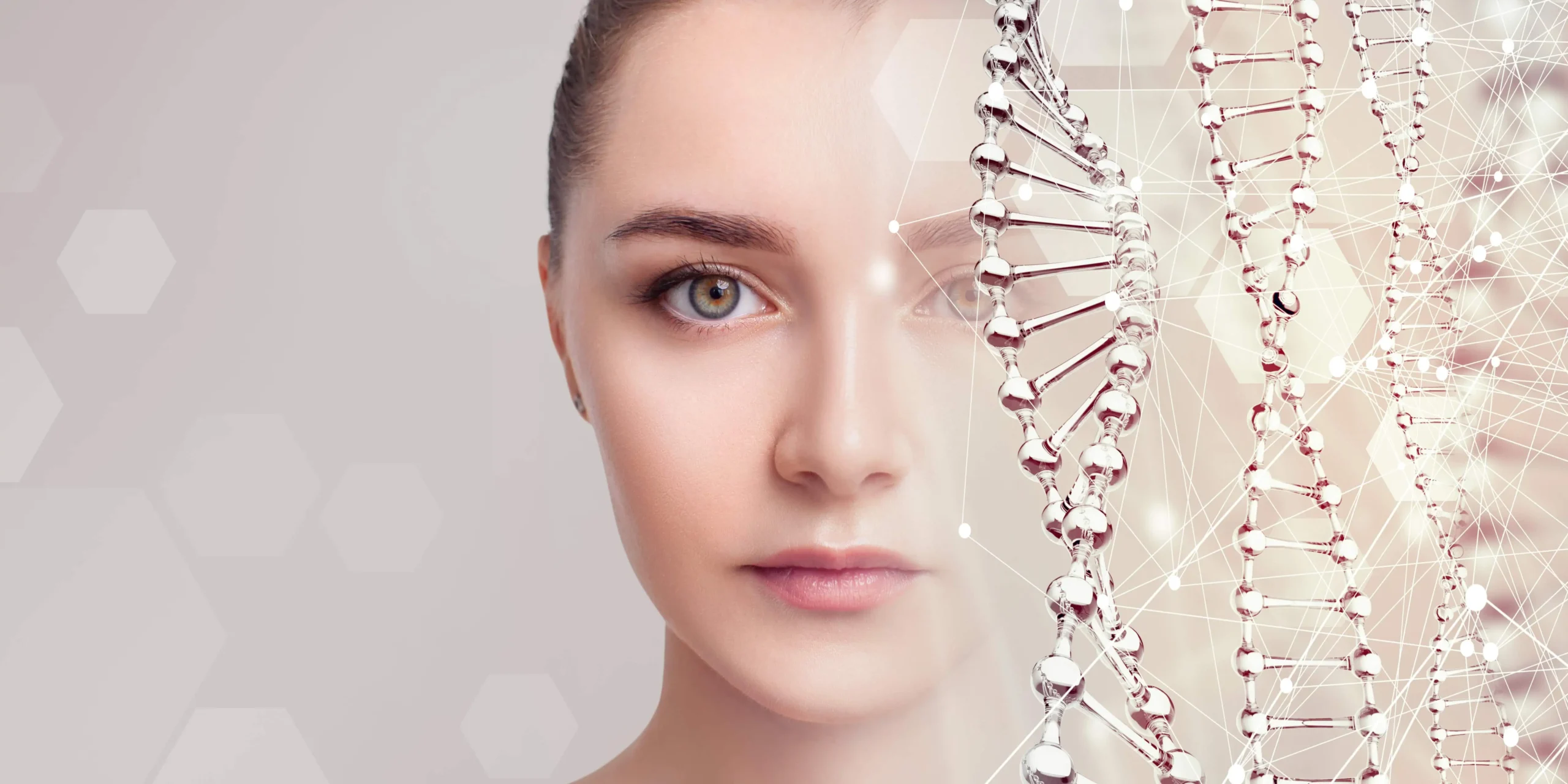Lounging in the sun and getting our daily dose of vitamin D can boost mood, improve sleep, strengthen bones, and even reduce high blood pressure. However, what once appeared as a deep, bronze tan can show up as sun-damaged skin on your face, chest, neck, and arms 20 years later. Without proper sun protection, sun-damaged skin can appear as fine to medium wrinkles, sagging skin, freckles, uneven skin tones, dark spots, or skin cancer. In short, refraining from sunscreen and unprotected hours (and years!) in the sun can prematurely age your skin. At Nova Vita, a core pillar is longevity through anti-aging services and habits. Read on to prevent and reverse sun damage to become a more youthful-looking you!
Nova Vita Solutions
Our red light therapy is a non-invasive treatment, cleared by the FDA, that delivers red light to a person’s skin and cells. It’s designed for skin rejuvenation and transforms the light energy it absorbs into cellular energy. The process boosts collagen production, which improves elasticity and makes your skin appear more youthful. Our Hydra facial also rejuvenates your skin through a hydrating treatment that enhances your skin health. Skin irritation and dehydration can increase signs of aging, and our Hydra facial can fight that dehydration without irritating your skin. Our Hydra facials are designed for all skin types and our healthcare professionals can choose specific serums and customize the treatment for your unique condition and needs. Get started with your treatment choice today by calling or booking an appointment online.
Photoaging vs. Chronological Skin Aging?
Chronological skin aging is your skin’s natural aging process according to your age and genetics. It’s not preventable. Photoaging is preventable and is caused by a lifetime of UV radiation exposure, mainly from the sun. Photoaging causes DNA changes in your skin cells and can lead to cancer. With proper sunscreen use and other safety precautions, photoaging can be significantly reduced.
What Can Sun-Damaged Skin Look Like?
Signs of photoaging can occur throughout your life and can show up as:
- Loss of elasticity in sun-exposed areas.
- Spider veins (broken capillaries) on your nose, cheeks, and necks
- Lines and wrinkles around your eyes and mouth that expand over time.
- Worry lines on your forehead at a young age.
- Pigment changes, color spots, freckles, and age spots.
- Uneven skin color or uneven skin texture.
- White spots on your arms, legs, and back of your hand.
- Thinning of your skin.
Who Is At Risk for Sun-Damaged Skin?
People of all skin tones are exposed to skin radiation and are at risk of sun-damaged skin.
However, you’re more at increased risk for sun damage if you:
- Have a lighter skin tone.
- Have had skin cancer or a family history of skin cancer, especially melanoma.
- Have had many moles and freckles.
- Have blue or green colored eyes and blonde, red, or light brown hair.
- Regularly get intense sun exposure on weekends while spending most weekdays indoors.
- Spend a lot of time outdoors and/or tanning salons, especially as a child/teenager.
Preventing Sun Damage
The best way to avoid sun-damaged skin is to prevent it early on in your life. Photoaging collects over a lifetime of sun exposure, and taking steps to limit exposure to UV radiation can reduce premature skin aging. Consider the following to lower your risk of sun damage and skin cancer:
- Wear broad-spectrum sunscreen that protects your skin against both UVA and UVB rays.
- Use water-resistant sunscreen with an SPF of 30 or higher. Apply sunscreen every day even when you’re mainly indoors or the weather is cloudy.
- Wear hats, sunglasses with UV protection, and lightweight long-sleeved shirts and pants.
- Look for clothing with an ultraviolet protection factor label for extra protection. These
can be found mainly in athletic wear. - Avoid the peak UV hours, usually between 10:00 am and 3:00 pm.
- Avoid all forms of tanning that damage your skin long-term. Consider a spray-on tanning product, tinted moisturizers, and other products that help you achieve a bronzed look without the risk of damaged skin.
Other suggestions to prevent premature aging (not solely from sun exposure) include:
- Stop smoking. It causes wrinkles and other fine lines and can lead to cancer.
- Eat healthy food, drink less alcohol, exercise regularly, and get adequate sleep.
- Gently cleanse your skin regularly. Make sure you’re washing off sweat as soon as
possible, as perspiration can irritate your skin. - Apply moisturizer every day that contains ceramides to keep your skin hydrated and
creates a natural barrier to seal in the moisture.
Treating Sun Damage
While sun damage cannot be completely reversed, some treatment options can help rejuvenate your skin:
- Retinoids: these compounds encourage skin cells to slough off and renew themselves,
improving skin cell turnover cycles. Retinoids stimulate collagen production, helping
keep skin tight; treat fine lines and wrinkles, and age spots, and reduce pore sizes. - Vitamin C and other antioxidants: These substances slow skin damage due to the
production of rogue chemicals, such as free radicals, that cause visible signs of damage.
Antioxidants can slow signs of aging, reduce UV damage to skin, and reduce collagen
breakdown. - Exfoliants: Exfoliants, such as alpha hydroxy acid, stimulate faster cell turnover.
Lightening agents: Whitening or brightening cosmetics typically include hydroquinone
and can lighten blemishes, sunspots, and uneven pigmentation. - Chemical peels: Chemical liquids such as trichloroacetic acid or glycolic acid are
applied to your skin. Peels remove the outermost layer of your skin so new skin will
come to the surface. As a result, the peel removes dark spots, treats fine lines and
wrinkles, and improves your skin tone and texture. - Laser therapy: Lasers remove the damaged top layer of skin and increase collagen
production, making the skin’s surface smooth. - Light-based therapy: Also known as photo rejuvenation, light-based therapy can
improve skin texture, redness, broken veins, blotchiness, and brown spots. Red light
therapy and green light laser can significantly improve fine lines and wrinkles, and other
consequences of sun damage. - Cryotherapy: This therapy uses liquid nitrogen to freeze noncancerous age spots and
actinic keratosis. Treated areas darken and shed in a few days. This process stimulates the growth of new, healthier skin cells, improving overall skin texture and appearance. - Fractionated non-abrasive lasers: These lasers create tiny wounds, deep in the skin to
create new collagen. As they heal, the skin resurfaces with a smooth, tight appearance.
Ablative lasers: These lasers are deeper lasers that vaporize the top layer of skin. They
are used for deeper pigmentation, unevenness, and deep-set lines and wrinkles.
The Takeaway
Preventing sun damage today is the best way to avoid the consequences of strong UV rays as we age. Incorporating a good daily skin regimen that includes protection can help you avoid photoaging and skin cancer. Missing a spot when applying sunscreen happens to us all, but being reckless with sun exposure is dangerous to your body long-term. Contact Nova Vita today to explore our services that target sun damage and other ways you can boost your longevity.






